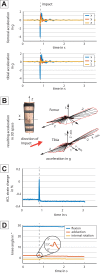Do Prophylactic Knee Braces Protect the Knee Against Impacts or Tibial Moments? An In Vitro Multisensory Study
- PMID: 30480009
- PMCID: PMC6240970
- DOI: 10.1177/2325967118805399
Do Prophylactic Knee Braces Protect the Knee Against Impacts or Tibial Moments? An In Vitro Multisensory Study
Abstract
Background: Knee braces are prescribed by physicians to protect the knee from various loading conditions during sports or after surgery, even though the effect of bracing for various loading scenarios remains unclear.
Purpose: To extensively investigate whether bracing protects the knee against impacts from the lateral, medial, anterior, or posterior directions at different heights as well as against tibial moments.
Study design: Controlled laboratory study.
Methods: Eight limb specimens were exposed to (1) subcritical impacts from the medial, lateral, anterior, and posterior directions at 3 heights (center of the joint line and 100 mm inferior and superior) and (2) internal/external torques. Using a prophylactic brace, both scenarios were conducted under braced and unbraced conditions with moderate muscle loads and intact soft tissue. The change in anterior cruciate ligament (ACL) strain, joint acceleration in the tibial and femoral bones (for impacts only), and joint kinematics were recorded and analyzed.
Results: Bracing reduced joint acceleration for medial and lateral center impacts. The ACL strain change was decreased for medial superior impacts and increased for anterior inferior impacts. Impacts from the posterior direction had substantially less effect on the ACL strain change and joint acceleration than anterior impacts. Bracing had no effect on the ACL strain change or kinematics under internal or external moments.
Conclusion: Our results indicate that the effect of bracing during impacts depends on the direction and height of the impact and is partly positive, negative, or neutral and that soft tissue absorbs impact energy. An effect during internal or external torque was not detected.
Clinical relevance: Bracing in contact sports with many lateral or medial impacts might be beneficial, whereas athletes who play sports with rotational moments on the knee or anterior impacts may be safer without a brace.
Keywords: ACL strain; acceleration; brace; kinematic analysis; knee.
Conflict of interest statement
One or more of the authors has declared the following potential conflict of interest or source of funding: This work was supported by the German Federal Ministry of Education and Research through the cooperative research project SE_BURG (grant No. 16SV6313). AOSSM checks author disclosures against the Open Payments Database (OPD). AOSSM has not conducted an independent investigation on the OPD and disclaims any liability or responsibility relating thereto.
Figures







Similar articles
-
The effect of knee braces on tibial rotation in anterior cruciate ligament-deficient knees during high-demand athletic activities.Clin J Sport Med. 2013 Jul;23(4):287-92. doi: 10.1097/JSM.0b013e31827ee800. Clin J Sport Med. 2013. PMID: 23348606 Clinical Trial.
-
The influence of functional knee bracing on the anterior cruciate ligament strain biomechanics in weightbearing and nonweightbearing knees.Am J Sports Med. 2000 Nov-Dec;28(6):815-24. doi: 10.1177/03635465000280060901. Am J Sports Med. 2000. PMID: 11101104
-
Effects of knee bracing on tibial rotation during high loading activities in anterior cruciate ligament-reconstructed knees.Arthroscopy. 2013 Oct;29(10):1644-52. doi: 10.1016/j.arthro.2013.07.258. Epub 2013 Aug 29. Arthroscopy. 2013. PMID: 23993058
-
Use of knee braces in sport. Current recommendations.Sports Med. 1995 Nov;20(5):281-301. doi: 10.2165/00007256-199520050-00001. Sports Med. 1995. PMID: 8571003 Review.
-
In vitro assessment of prophylactic knee brace function.Clin Sports Med. 1990 Oct;9(4):823-41. Clin Sports Med. 1990. PMID: 2265440 Review.
Cited by
-
Hip and Knee Bracing: Categorization, Treatment Algorithm, and Systematic Review.J Am Acad Orthop Surg Glob Res Rev. 2021 Jun 7;5(6):e20.00181-12. doi: 10.5435/JAAOSGlobal-D-20-00181. J Am Acad Orthop Surg Glob Res Rev. 2021. PMID: 34096901 Free PMC article.
-
Experimental mechanical strain measurement of tissues.PeerJ. 2019 Mar 7;7:e6545. doi: 10.7717/peerj.6545. eCollection 2019. PeerJ. 2019. PMID: 30867989 Free PMC article.
-
Functional Bracing After Anterior Cruciate Ligament Reconstructions: A Review of the Current Literature.J Pediatr Soc North Am. 2025 May 30;12:100215. doi: 10.1016/j.jposna.2025.100215. eCollection 2025 Aug. J Pediatr Soc North Am. 2025. PMID: 40686529 Free PMC article. Review.
-
Sport-Specific Injury Mechanisms and Situational Patterns of ACL Injuries: A Comprehensive Systematic Review.Sports Med. 2025 Jul 21. doi: 10.1007/s40279-025-02271-w. Online ahead of print. Sports Med. 2025. PMID: 40690162
References
-
- Arnold JA, Coker TP, Heaton LM, Park JP, Harris WD. Natural history of anterior cruciate tears. Am J Sports Med. 1979;7(6):305–313. - PubMed
-
- Baker BE, VanHanswyk E, Bogosian SP, Werner FW, Murphy D. The effect of knee braces on lateral impact loading of the knee. Am J Sports Med. 1989;17(2):182–186. - PubMed
-
- Besier TF, Lloyd DG, Achland TR. Muscle activation strategies at the knee during running and cutting maneuvers. Med Sci Sports Exerc. 2003;35(1):119–127. - PubMed
-
- Beynnon BD, Johnson RJ, Fleming BC, et al. The effect of functional knee bracing on the anterior cruciate ligament in the weightbearing and nonweightbearing knee. Am J Sports Med. 1997;25(3):353–359. - PubMed
-
- Beynnon BD, Johnson RJ, Fleming BC, Stankewich CJ, Renström PA, Nichols CE. The strain behavior of the anterior cruciate ligament during squatting and active flexion-extension: a comparison of an open and a closed kinetic chain exercise. Am J Sports Med. 1997;25(6):823–829. - PubMed
LinkOut - more resources
Full Text Sources

